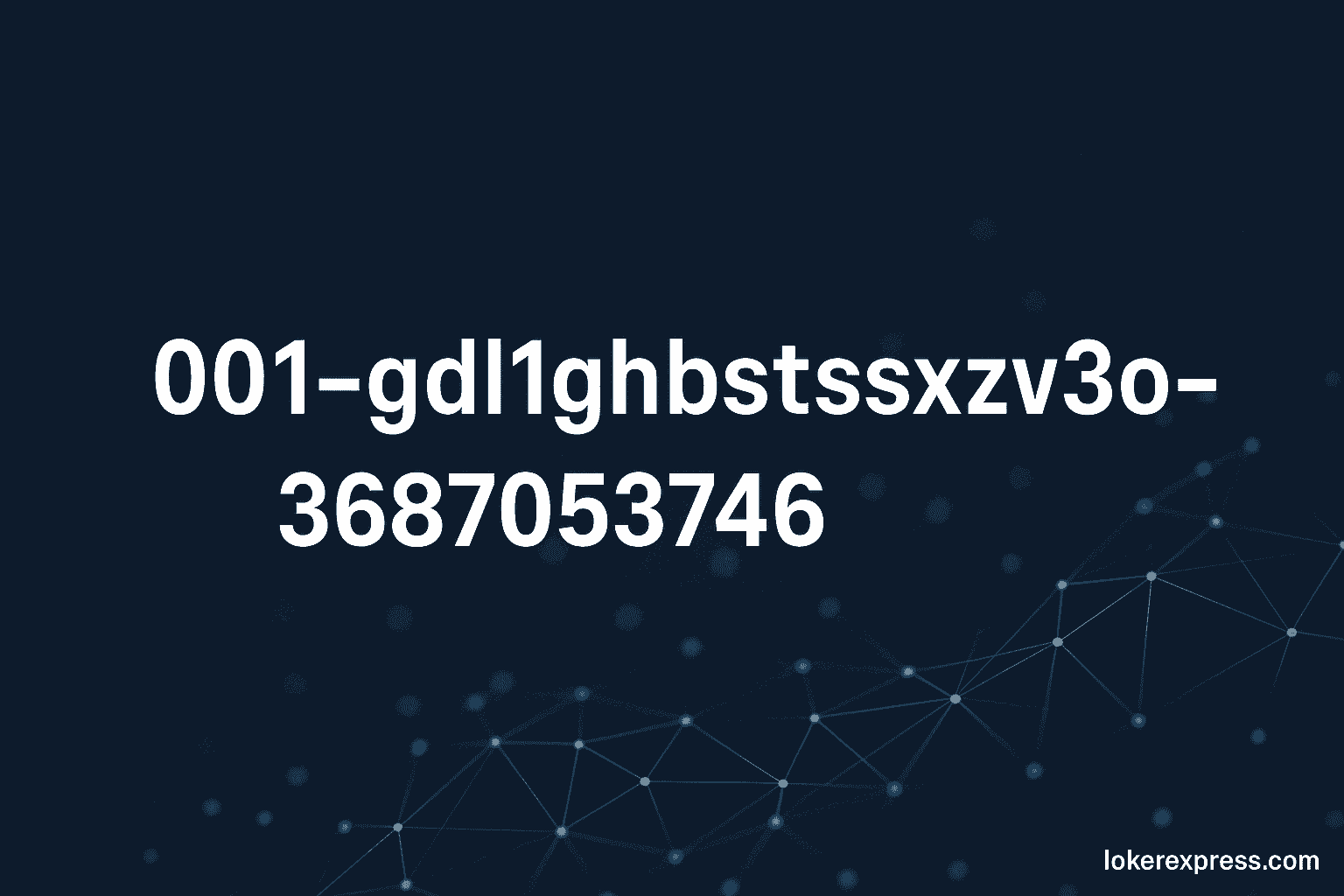Introduction: The Rise of Complex Identifiers in the Digital Age
In today’s data-driven world, the use of unique identifiers has become a cornerstone of organizing, managing, and safeguarding digital assets. One such complex identifier—001-gdl1ghbstssxzv3os4rfaa-3687053746—may appear random at first glance. However, such a string often has specific meaning, structure, and utility embedded within it. Whether it relates to product tracking, data management, cryptographic security, or digital records, this identifier encapsulates the need for precision and uniqueness in modern systems.
This article unpacks everything you need to know about 001-gdl1ghbstssxzv3os4rfaa-3687053746, offering insight into its possible origins, applications, structure, benefits, and relevance across industries.
What Is 001-gdl1ghbstssxzv3os4rfaa-3687053746?
The string 001-gdl1ghbstssxzv3os4rfaa-3687053746 is a globally unique identifier (GUID) or universal unique identifier (UUID) used in many data systems to ensure that records and objects can be distinguished from one another. While the specific use of this string may vary depending on context, it typically serves as a non-sequential reference that avoids duplication and supports cross-platform consistency.
These identifiers are especially critical in scenarios where records are generated frequently, or when data must remain distinct across systems and networks, such as in cloud computing, software versioning, and database indexing.
Breaking Down the Structure of the Identifier
To fully understand 001-gdl1ghbstssxzv3os4rfaa-3687053746, it’s helpful to dissect its components:
- 001: This prefix could represent a version number, region code, or category ID. Prefixes like these are common in enterprise software to denote types or classifications.
- gdl1ghbstssxzv3os4rfaa: This portion is an alphanumeric string likely generated by an algorithm designed to ensure uniqueness, such as a hash function or UUID generation tool.
- 3687053746: A long numeric sequence such as this often represents a timestamp, internal object ID, or indexed value.
This multi-part structure enables the identifier to be machine-readable, non-colliding, and compatible across different systems, which is essential in scalable software or big data environments.
Why Unique Identifiers Matter in Technology
Unique identifiers like 001-gdl1ghbstssxzv3os4rfaa-3687053746 are not created at random—they solve critical problems in technology. As applications, websites, and services scale, the volume of data increases exponentially. Without unique IDs:
- Data could be overwritten or duplicated.
- User information could get mismatched.
- Logs, transactions, and histories might become unreliable.
Imagine an e-commerce platform managing 100 million products. Without unique identifiers, managing inventory or syncing records across warehouses and vendors would be nearly impossible. Likewise, APIs and distributed systems rely on these identifiers for secure communication between clients and servers.
Use Cases Across Industries
This identifier—or others like it—has relevance across virtually every sector:
1. Healthcare
In electronic health records (EHRs), unique IDs ensure that patient data remains isolated and accurate. For instance, blood test results, imaging, and doctor notes are all tied to a patient’s unique identifier to avoid confusion and enhance privacy.
2. Finance
Banks and fintech companies use unique strings to track transactions, identify accounts, and ensure secure transfers. Fraud detection systems also rely heavily on identifiers to spot unusual activity linked to a specific ID.
3. Logistics & Manufacturing
Every product, shipment, and component can be assigned a unique ID for traceability. In case of recalls or audits, identifiers help track the origin and distribution path of affected items.
4. Software Engineering
Developers use UUIDs to differentiate between user sessions, application instances, and system logs. This is particularly critical in cloud environments with thousands of microservices.
5. E-commerce
From SKUs to order numbers and cart IDs, identifiers help track the lifecycle of a customer’s experience—from browsing to checkout and delivery.
Security Implications of Using Complex Identifiers
Identifiers like 001-gdl1ghbstssxzv3os4rfaa-3687053746 are often designed to enhance data security and anonymity. Rather than revealing sensitive information (e.g., usernames or IP addresses), systems use cryptic IDs to:
- Obfuscate internal data from end users or attackers.
- Prevent reverse engineering of database structures.
- Isolate users and actions in a tamper-proof way.
When paired with cryptographic protocols or token-based authentication, these identifiers can further secure data against leaks or manipulation.
Generating Identifiers: Algorithms and Methods
The identifier we’re examining is likely generated by one of several methods:
- UUID (Version 1–5): Universally unique identifiers based on time, random numbers, names, or SHA hashing.
- Hash functions (e.g., SHA-256, MD5): Convert input into a fixed-size alphanumeric output.
- Custom Algorithms: Some companies implement internal ID generation logic that combines timestamps, user info, region codes, and entropy sources.
These generators are engineered to avoid collisions, even when generating billions of entries, ensuring that each ID is distinct across time and space.
Common Challenges with Unique Identifiers
Despite their advantages, using identifiers like 001-gdl1ghbstssxzv3os4rfaa-3687053746 is not without challenges:
- Readability: Human users can’t easily interpret or remember long strings, making customer support or error tracking difficult.
- Storage Overhead: UUIDs are often longer than traditional numeric IDs, increasing database size and query times.
- Debugging Complexity: Debugging systems using opaque identifiers can be time-consuming unless the mapping logic is well-documented.
That said, most modern systems are optimized to handle such overheads, and the benefits usually outweigh the costs.
Best Practices for Working with Identifiers
When using or designing systems around identifiers like this one, follow these best practices:
- Use Indexing: Optimize your database with indexes on identifier fields to improve performance.
- Document the Structure: Even if generated automatically, knowing what each segment represents helps in debugging and audits.
- Avoid Exposure in URLs: Hide or encrypt identifiers to protect system logic and user data.
- Consistent Format: Ensure your system handles identifier casing, encoding, and formatting consistently across services.
A well-planned identifier system is crucial for maintaining a scalable and secure data environment.
The Future of Unique Identifiers
As digital ecosystems become more connected—through APIs, IoT, and AI—the importance of identifiers like 001-gdl1ghbstssxzv3os4rfaa-3687053746 will only grow. Future trends include:
- Self-describing IDs: That include metadata or timestamp info encoded in the string.
- Blockchain-compatible IDs: Immutable, traceable identifiers tied to decentralized ledgers.
- AI-driven ID mapping: Systems that can intelligently map or interpret IDs across datasets using machine learning.
The need for global interoperability and automation means that systems must invest in robust and forward-compatible ID strategies.
Read More: New Software RCSDASSK: Everything You Need to Know in 2025
Conclusion: Why This Identifier Matters
The string 001-gdl1ghbstssxzv3os4rfaa-3687053746 is more than a jumbled mix of letters and numbers—it’s a symbol of the complex yet necessary systems that power the digital world. From ensuring data integrity and enhancing security to enabling scalability across industries, identifiers like this one are foundational to modern technology.
Understanding how these identifiers work, why they exist, and how they’re used helps developers, analysts, and decision-makers build smarter, more efficient systems. Whether you’re managing a small database or designing an enterprise-scale platform, never underestimate the power of a well-structured unique identifier.

